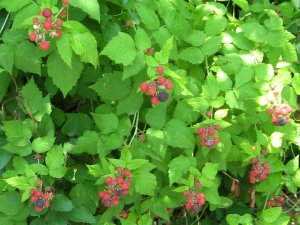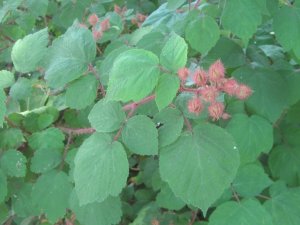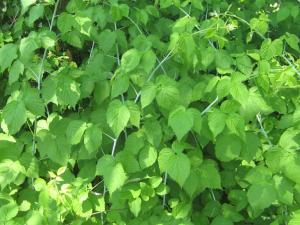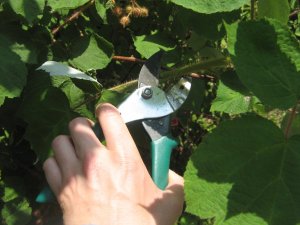This post is about two delicious types of fruit, both of which grow wild in my yard here in Delaware. One of them, the black raspberry, is native to the eastern United States. The other, the Japanese wineberry, is a non-native, naturalized plant that is invasive in some areas, displacing native vegetation and reducing biodiversity.
This post will give a little basic background on these two species of raspberries, including a few tips and tricks of how to identify them, how to grow them effectively, and how to control Japanese Wineberries when they are invasive.
Black Raspberries:
The black raspberry is native only to North America. The plant is broken into two closely related species, Rubus occidentalis, found in the east, and Rubus leucodermis, found in the west. Although black raspberries are black in color and look superficially like blackberries, they are more closely related to red raspberries, and only more distantly related to blackberries.
Black raspberry plants are easily identified by their bluish-white stems. The plants tend to have three leaflets, and the stems are quite thorny (hence the name raspberry).
 Black raspberries are native to much of North America. Black raspberries are high in anthocynanins, chemicals present in many berries. Anthocyanins have received attention for their antioxidant activity and potential health benefits.
Black raspberries are native to much of North America. Black raspberries are high in anthocynanins, chemicals present in many berries. Anthocyanins have received attention for their antioxidant activity and potential health benefits.
Distinguishing Blackberries from Black Raspberries:
The fruit of black raspberries are easily distinguished from blackberries by the fact that on blackberries, the stem comes off and remains attached to the berry, after picking, whereas when picking all raspberries, the stem remains on the plant and the berry comes off with an empty cup where the stem was. Blackberry plants also tend to have different looking leaves–many species of blackberry have leaves with a set of five leaflets radiating from a single point. Also, raspberries (black, red, and wineberries) tend to have white undersides to the leaves whereas blackberries tend to have green leaves on both sides. Blackberry leaves often tend to be a slightly darker green color.
Japanese Wineberries:
The Japanese Wineberry, Rubus phoenicolasius, is a species of raspberry native to China, Japan, and Korea. This species is very similar to black raspberries in many respects, although the two species are unmistakeable due to dramatic differences in the plants and berries. Whereas black raspberries have white, thorny stems, wineberries have hairy red stems. Unlike black raspberries, which mature and ripen out in the open, wineberries remain covered until a few days before they ripen. The berries are named for the fact that they become the color of red wine when ripe–a very deep purplish red. Compared to other red raspberries, the berries are firmer and slightly more tangy in flavor.
Red Raspberries:
Although this post isn’t about them, there are also several species of red raspberries, including ones native to North America, Europe, and Asia. Distinguishing between these species is subtle. I have less experience with red raspberries, and they do not grow wild in my yard, which is why I have omitted them from this post.
Growing Berries for Food:
Black raspberries ripen earlier than wineberries and the two species dovetail nicely, with wineberries beginning to come ripe just as the black raspberry crop is winding down. Here in Delaware, black raspberries come ripe around the second week in June, and come in steadily for two weeks. Wineberries then continue for a few more week.
Both black raspberries and wineberries are biennials, meaning that they have a two-year life cycle. During the first year, the plants put up tall, straight shoots, which eventually fall over and touch the ground. The tip of the shoot then grows into a new plant, and the old shoot becomes woody. After the winter, the old shoot puts out some leaves (but little new shrubby growth), flowers, and fruits, and the new plant becomes a new first-year shoot. In this manner, raspberries spread both by seed, and vegetatively. Under the right conditions, raspberries will reproduce prolifically by both means. However, keep in mind that raspberries take several years to get established and reach full productivity: the largest harvest from them will not come for a number of years after you have initially planted them.
Raspberries require little care when grown in their native habitat under the right condition. Both species grow best in partial sun on edges between yards or grassland and forest, or in open woods or a partly-shaded yard. Rather than planting raspberries in an exposed area in a garden (which exposes them to pests and make them harder to maintain), it’s best to plant them in a marginal area that you don’t want to put as much effort into maintaining. The perfect place to plant them is around the edge of a yard, near a fence or hedge. You can also plant them on disturbed ground on property that is not maintained. I harvest a rich crop of raspberries every year, and I have never watered or fertilized them, not even with compost. The only care I give them is to occasionally cut back vines and shrubs which are crowding them out, but even this is usually unnecessary–they are aggressive plants which can hold their own against just about anything else.
Controlling Invasive Wineberries:
Wineberries are invasive in many areas. They can form dense thickets which shut out native plants, and for this reason, many people want to control them. However, it is important to use the principle: do no harm. Some people advocate usage of chemical herbicides to control wineberries and other invasive plants: I strongly recommend against this practice, as it is both unnecessary and has the potential to cause more harm than the invasive species cause to begin with.
I have found wineberries very easy to control by replacing them with black raspberries. The two species are very closely related, have very close requirements, and can even easily co-exist in the same area (great for you if you harvest them). Once black raspberries have been established, a few hours of pruning the wineberries back every couple weeks during the summer will quickly allow the black raspberries to achieve dominance. You can then choose to eliminate the wineberries or leave enough to enjoy harvesting them yourself.
Do not use electric or gas-powered trimmers. This is a brute-force attempt that kills all vegetation. It will not control the wineberries because they will aggressively resprout and may even dominate after cutting. Such trimmers are also energy intensive, and unsustainable. If you live in a residential neighborhood, they are noisy and create a public nuisance. Instead, take a simple pair of mechanical pruning shears or clippers and selectively cut the stems manually. Look at what you are cutting, and only cut what you want to get rid of:
If you wish to eventually eliminate the wineberries, cut the stems back to the ground. If you wish only to increase the yield of black raspberries relative to wineberries, cut the stems back only partway, or only cut some stems. Leave the cut stems to decompose on the ground. Wineberries are aggressive growers that resprout readily, but they are easy to cut and will eventually die out if they are being cut back to the ground several times a summer. Since you are cutting them selectively, they will be shaded out by the other plants around them–when you cut back the wineberries, the other plants will expand to fill the gaps, shading out the wineberries.
This practice requires minimal effort, uses only the energy of your own body, and causes minimal disturbance to the ecosystem. It also uses other plants to shut out the plants you are trying to control. It is ultimately much more effective than brute-force attempts like those involving chemicals, or power mowers, edgers, or trimmers. This technique is useful for controlling many types of invasive plants, not just wineberries.
What can you do?
- If you live in North America, consider growing black raspberries. If you live in China, Japan, or Korea, consider growing wineberries.
- If wineberries or another edible raspberry are invasive in your area, consider harvesting them. They’re tasty, nutritious, and each berry you eat is one more berry that won’t help the spread of an invasive plant.
- Learn to identify different types of berries and watch when they come ripe in your area, so that you can plan when to harvest them, and so that you can make decisions that lead towards the protection of native plants and the control of invasives.
- If you desire to control invasive plants such as the wineberry, first plant an appropriate, aggressive native plant (like a black raspberry), and then follow the simple mechanical control regime recommended here, using mechanical pruning shears to selectively prune back the plants you are trying to control. Avoid the use of chemicals and energy intensive electric- or gas-powered trimmers.




A wonderful posting! I ate a lot of my wineberries this year, and they were delicious. I will definitely plant some black raspberries. I also agree that pesticides etc are a terrible way to “control” invasive species. I’m not sure how “invasive” I consider an edible plant.
When should they be planted initially – Fall, Spring, Summer?
I think this would depend on how / when you’re propagating them. If you’re buying first-year plants, I’d plant them in spring so that they have ample time to grow into large stalks, and layer, so that next year you’ll get some berries and a lot of new first year stalks.
If you’re layering from existing stalks, such as in a neighbor’s garden or in the wild, I’d wait till the plants are starting to touch the ground, and then place pots and soil and gently bend the stalks into the pots so that they will grow a new plant in the pot, then transplant these in the fall. This will be a slower method, but it has the advantage that it’s free. You can also select a plant that has particularly lush and delicious berries.
These plants also grow readily from seed; the seeds are dropped by birds and will come up anywhere the conditions are right. If you live near a wild area that is located near large raspberry patches, you can often find newly sprouted plants in sunny, exposed patches of thickets and other areas that are somewhat disturbed but still have relatively rich soil and leaf litter. When they are small, they are easily transplanted, and will grow into first-year stalks. These stalks often won’t be quite as vigorous as those produced by layering of existing plants, especially if the existing plants were themselves very vigorous. But growing from seed has the advantage of promoting genetic diversity, which will make your raspberry patch more resilient and resistant to pests. Diversity can also promote some variation in the size and flavor of the berries, which can be nice if you find a particularly tasty plant. I haven’t seen much variability in wineberry size and flavor, but black raspberries definitely vary significantly in size and also juiciness.
We here in Hyde Park NY have quite a few patches of wineberries. Most that I have seen are only about ten feet in diameter and don’t seem to grow too much larger. Then again, they are usually found in the woods and aren’t messed with, so have no help in growing out of control. They are delicious, but I have wondered about the plant compounds involved which make them sticky- medicinal or repellant, maybe, to keep bugs away?
can wineberries be grown in Central Florida?
Hmm…Central Florida would be considerably warmer than their optimal environment. I also recommend avoiding planting non-native plants, especially one like Wineberries whose fruit tends to be less enjoyable than many native alternatives.
But, in general, raspberries and their close relatives tend not to do well in Florida…it is too warm.
Blackberries, on the other hand, are another story…there are several species of blackberry native to Florida, and they can grow well there with little effort, given the right conditions. But I’m no expert on this, having never gardened in Florida, so I wouldn’t know where to point you in terms of specific species or cultivars. Good luck! In the end, there is much more that you can grow in Florida than things you can’t…raspberries are really more of a cold-weather crop, so utilize your warm climate to grow subtropical fruits that people in the north cannot grow!
Where can you buy Japanese wine berry plants? We don’t seem to have them in Idaho.
Idaho is much colder in the winter, and they may not do as well there. Wineberries seem to thrive in more southerly areas–like southeastern Pennsylvania and Delaware. I know that red raspberries tend to thrive in colder climates. I’d advise going with some of the native varieties of red raspberry. Most people seem to think they taste better anyway–and they also retain their flavor more when cooking, so can be made into better pies and jams.
But there’s also the consideration that it’s not a good idea to introduce new potentially invasive plants into an area that they have not been introduced to. Either wineberries would or wouldn’t do well in Idaho, but if they would do well, it would probably be better for the local ecosystems to keep them out.
Both of these factors may explain why you don’t see them for sale, and why it is probably not a great idea to plant them in Idaho.